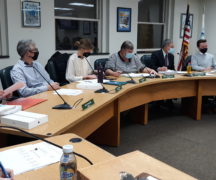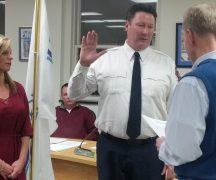By JAN LARSON McLAUGHLIN
BG Independent News
Bowling Green City Council was torn Monday evening on whether to scrap or salvage a controversial part of the city’s zoning code update.
After listening to nearly an hour of opposition to the zoning code update that will allow some businesses in some neighborhoods, Bowling Green City Council took a vote on the new zoning category.
Two members – Greg Robinette and Nick Rubando – voted to scrap the pedestrian residential zoning category. Five members – Jeff Dennis, Bill Herald, Mark Hollenbaugh, Joel O’Dorisio and Rachel Phipps – felt the zoning might be salvageable and deserved further study.
The vote came after 13 residents testified about the hardships this new zoning category would create for them. The pedestrian residential zoning, proposed for the blocks running on each side of Main Street from Poe to Napoleon roads, would allow for some businesses, and would shrink lot frontages and setbacks.
During a work session after the regular meeting, City Council delved deeper into the zoning details.
City Planning Director Heather Sayler reported that nearly 80% of the parcels in the proposed pedestrian residential zone already don’t meet the current lot frontage requirements.
When the city’s GIS coordinator looked at the existing lot sizes, it was found that 1,745 of 2,226 lots are under the current 60-foot width requirement. Nearly 30% are less than the proposed 30-foot minimum.
A primary goal of the pedestrian residential zoning is to make neighborhoods more walkable.
William Robert Reichert, of South Church Street, said Bowling Green is already very walkable.
“Bowling Green has been a haven to us,” he said. But the zoning update could change that.
Reichert said if he happens upon the “It’s a Wonderful Life” movie over the holidays, “I want to feel like I live in Bedford Falls and not Pottersville.”
A Buttonwood Avenue resident, Suzanne Midden, also objected to the idea that the pedestrian residential zoning is needed to make the city more walkable.
“I hate to be a naysayer,” she said. “We don’t have a problem with walkability. I walk every day.”
Midden questioned the zoning change that would lead to more businesses and rentals in neighborhoods. “We already have lax code enforcement on this,” she said.
Anne Bullerjahn, of North Maple Street, described her recent walk from her home to dinner at Juniper downtown, then to the Black Swamp Players Theater.
“I do not understand why there needs to be a new designation,” she said, asking that the city keep R-2 zoning in the neighborhoods bordering Main Street. “This is a really bad idea.”
Others voiced concern about the pedestrian residential zoning siphoning off businesses from the downtown.
“I want to preserve and protect our neighborhoods” including the downtown, said Sandy Wicks, who has started several businesses including Grounds for Thought and Call of the Canyon Cafe.
Bowling Green’s historic downtown survived the influx of malls and big box stores in the 1980s, she said. This zoning change threatens to weaken the downtown, she added.
“We need to support the downtown – not pull businesses away,” Wicks said.
North Prospect Street resident Les Barber pointed out the growing citizen movement against the pedestrian residential zoning. He questioned why the city scrapped the 2018 Community Action Plan, which focused on halting the degradation of housing standards.
The new zoning category is a “social experiment” that would not be good for Bowling Green, Barber said.
Steve Ricard, of West Wooster Street, brought up the topic that all homeowners in the proposed pedestrian residential district are thinking about.
“What do you think that will do to the value of our properties?” Ricard said.
Penny Evans-Meyer, of Buttonwood Avenue, warned the zoning would allow for businesses right next to homes, would lead to more on-street parking, more traffic, and shrinking lots.
“The proposed pedestrian residential district is already very walkable,” she said.
Carol Smestad, of South Church Street, surmised that the consultant who proposed the pedestrian residential zoning was perhaps planning for a bigger city.
“He really doesn’t understand the nature of this community,” she said. “I’m not against development,” but this plan isn’t right for Bowling Green.
John Sampen, of North Maple Street, inquired about the value of pedestrian residential zoning, if it’s only being proposed for older neighborhoods – not the Westgate or the golf course subdivisions.
“I think we should share this with the whole city,” he said.
Anesa Miller said people often comment on the charm of Bowling Green’s downtown and surrounding blocks of historic homes. She asked if the proposed zoning would leave the historic buildings “hanging out to dry.”
Residents who have invested in the historic neighborhoods rather than rushing to the edges of the community should not be disregarded, she said.
Vassiliki Leontis, of North Summit Street, spoke of her experiences living next to businesses on East Wooster Street.
“I know what it means to be very close to businesses,” she said, listing the trash from the stores, the light pollution, and the noise from delivery trucks and garbage trucks doing pickups at 4 a.m.
David Drain, of East Court Street, hears those same garbage trucks at 4 a.m. The lights and noise devalue the homes, he said.
Residents bought in those older neighborhoods to restore historic homes, with the promise of the areas staying residential, he said.
Drain also questioned the walkability rationale.
“If we want to make the area more walkable, why don’t we fix the sidewalks,” he said, noting that people using wheelchairs cannot traverse the sidewalks in his area because of missing chunks of concrete.
Rose Drain also voiced her objections.
“The historic downtown district and surrounding blocks are a treasure,” she said.
The zoning change could “siphon businesses away” from downtown and violate a vow between the city and homeowners. “Isn’t it a betrayal of trust to change the zoning now?”
And Christen Giblin, of North Prospect Street, tried to clear up misconceptions that those opposed to the zoning change are anti-rental.
“Most of us have had to rent before we bought,” she said. “I think what we need are more responsible landlords.”





